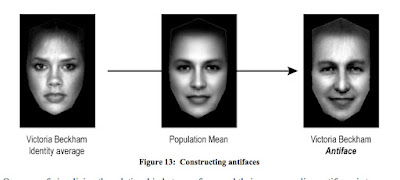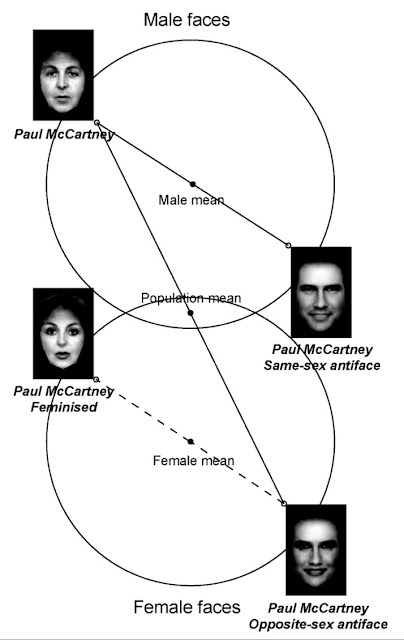This antiface is virtual image generated by a computer. The software begins by identifying your unique facial metrics from a data set of photos. Then it generates a 3D representation of your face called your "identity average."

The computer compares the metrics of your identity average with those of the population average. Then it generates a new face with opposite metrics. So if you have a narrow forehead, your antiface will have a wide forehead. If your eyes point up in the outer corners, the eyes of your antiface will point down. If you have a bit of a frown, your antiface will have a bit of a smile.
R. Jenkins and A. M. Burton, the scientists who worked on this study, were unsure whether using metrics alone to make an antiface would generate a plausible photographic face. "It was not obvious in advance that this would be the case," they said.
Further, they observed that "psychologically relevant dimensions such as sex and emotional expression are reversed by this process (female becomes male; sullen becomes cheery), even though these dimensions are not explicitly coded at any stage. In addition, all aspects of the physical appearance of the face take on the opposite valence, so that dark complexion becomes light complexion, upturned nose becomes downturned nose, etc."
They also discovered that, because of the effects of accommodation, if you look long enough at an antiface and then switch to a looking at an average face, even the average face will take on qualities of the individual in question.

You can generate an antiface across the gender mean to output a same-sex antiface. Or you can use the data to render an opposite-sex version of your face. Or you can use it to create an opposite-sex antiface. The photo shows Paul McCartney's face taken through all those permutations.
Being able to look at an antiface would be an aid to portrait painters or caricaturists, because it makes clear what is unique about a given face.
More about Antifaces R. Jenkins and A. M. Burton







12 comments:
There's an app link seems to dead end...
It works using Google Chrome, the app is called Antiface by Woodley in Google Play.
Stuff like this is very interesting to me as I want to try my hand at caricature painting soon. :)
I would think this would also be helpful to novelists who are character-driven writers. Thinking up the players and how to describe them must be a challenge, especially in novels with tons of people.
Somewhere I once read that people don't make up a "face" out of a complete blank slate - that they always have to think of a specific human and then work from there.
This is a bit out of thread, but all this thing about average faces made me think to how the zoologists describe new species. While the use of DNA is becoming more common, the majority of zoologists still prefer the "morphologic species" technique that has been used for centuries: when they have to define how a new species looks like, they have to choice one specimen among the others they collected that more or less seems to be the average of all of them. Shapes, pattern, metrics, scientists try to find the average of all of them. If a group of specimens looks quite different from this average, it becomes another species or a subspecies. With time, this description is updated and species becomes subspecies of others or subspecies become real species: in other words, they try to guess on the basis of the average aspect. And while there are softwares that analyze the shape and try to outline the average shape, the experience and the eye plays a great role in it. I've always wondered what conclusions an alien scientist would obtain if he'd apply the same method to humans: probably he'd use something like the average face and the antiface... :)
Has there been any research done on the effectiveness of facial recognition being able to distinguish between identical twins? The software coders are making scary fast progress, but simple things still seems to trip up the computers. To my non-scientific noggin' that would seem to be a good litmus test of the software's capability.
A better way (to my mind) is the knowledge that the left and right halves of each face are enough alike to "look like" that person, but enough different that when viewed in a "glued together" manner, makes the resulting pair of faces look "face and antiface." In the old days, we used a mirror and placed the face at the a right angle to the edge of the mirror and photographed the result, and did it again for the "other half" of the face. The results, while similar, produced two different looks.
I am curious how all this facial recognition technology deals with makeup. The purpose of that stuff is to change and disguise a person's natural appearance. Can the workings of these programs somehow see through that? It's interesting in today's example that the feminized version of Paul McCartney seems to have been achieved mostly by adding makeup effects, and the feminine and masculine antifaces look very similar.
Is it just me or is the opposite of Victoria Beckham a young Georgia O'Keefe?
This is wildly interesting. We've been having a grand time talking about it over here. Thank you for making this post.
In the Beckham example and the Paul McCartney example the antifaces have larger lower lips than upper lips but so does the original face. I wonder why the software wouldn't change that striking feature? Makes one wonder what else it missed.
Post a Comment